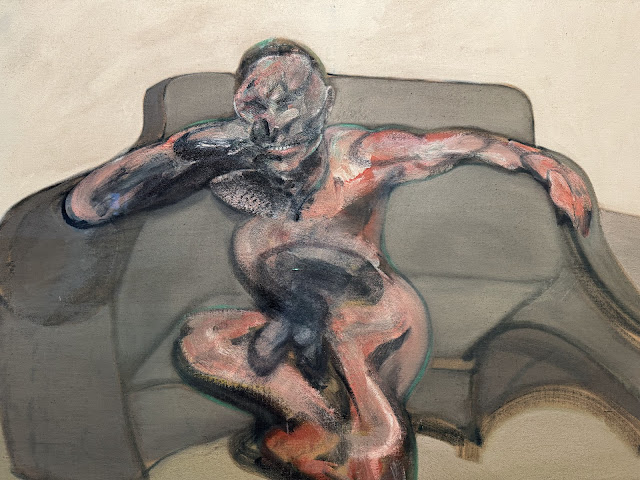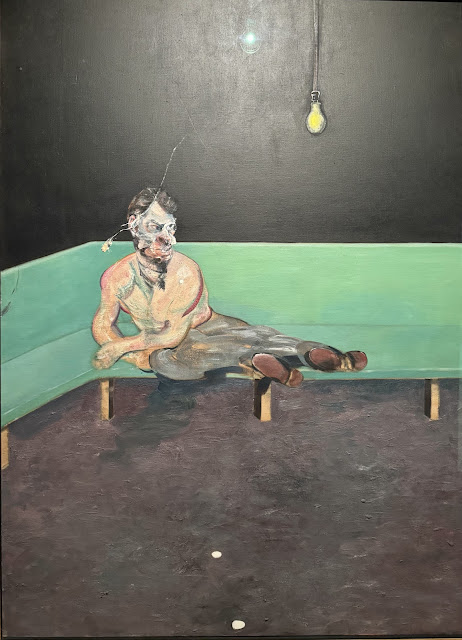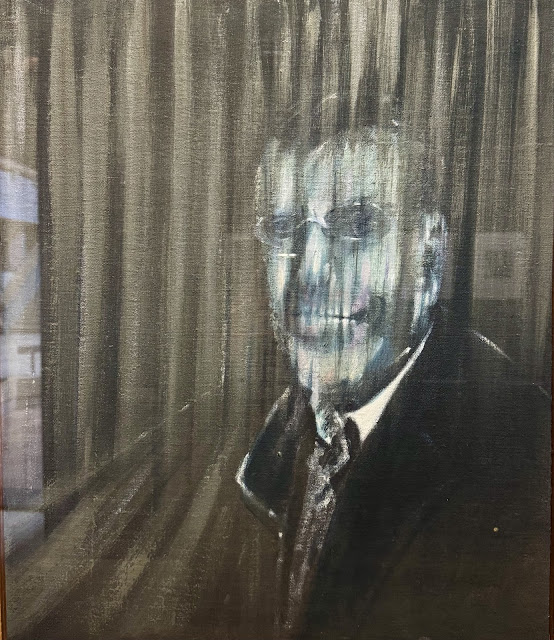FRANCIS BACON
HUMAN PRESENCE
In Collaboration with the National Portrait Gallery, London
Fondation Pierre Gianadda,
14 FEVRIER- 8 JUNE ,
MARTIGNY, SWITZERLAND
Curator; Rosie Broadley
Reporter; Nazli Kok Akbas
19 March, Martiny
(Photography copyright, Nazli Kok Akbas, NKA Art Reports Switzerland-France-Istanbul Photography 2024. All rights reserved)
(Detail), Francis Bacon, Portrait, 1962, oil on canvas, The Lambrecht- Schadeberg Collection, Contemporary Art Museum of Siegen.
Francis Bacon:Human Presence is the first exhibition in nearly 20 years to place its focus on the Francis Bacon's portraits.
This "biting" and "moving" exhibition is sure to be a source of amazement for visitors in Gianadda Foundation.
Francis Bacon, Study for Portrait II, (after the Life Mask of William Blake) 1955, oil on canvas,Tate London.
Francis Bacon was born in Dublin in 1909, the second of five children of English parents who had recently settled in Ireland. His father was a retired army major and his mother came from a Sheffield family who had made their fortune in steel.
Bacon was raised by the family Nanny, Jessie Lightfoot, a maternal figure who remained close to him until her death.
It is belived by most art critics that Bacon's interest in a working class perspective developed due to his tender relation with Mrs.Lightfoot.
At the age of 17, his emerging homosexuality severely strained relations with his family especially with his father and he was expelled from the household.
Francis Julian Gutmann, Francis Bacon, 1933, MB Art Collection.
Francis Bacon radicaly redefined portraiture in the art history. The faces in his paintings are distorted and deformed, revealing mortality, sex, pain and very often leaving his subjects feeling wounded.
Francis Bacon, Self-portrait, 1972, oil on canvas, The Lewis Collection.
Francis Bacon made ten self-portraits in 1972, more than any other year.They are mournful and are undoubtedly a response to the recent death of his partner, George Dyer.
Bacon has long been regarded as one of the most outstanding painters of the twentieth century.In our digital age, when almost all portraits are outomatically retouched by hand, his portraits come as a great shock.
(Photography copyright, Nazli Kok Akbas, NKA Art Reports Switzerland-France-Istanbul Photography 2024. All rights reserved)
Study for Portrait of Lucian Freud,1964, Oil on canvas, The Lewis Collection.
Arnold Newman, Francis Bacon, 1975, National Portrait Gallery, London.
Francis Bacon:Human Presence
The exhibition explores the artist's deep and complex engagement with portraiture as a response to the portraits painted by earlier artists and as a memorial to his lost lovers.
The exhibition in Gianadda Foundation features more than 30 works by Francis Bacon from private and public collections around the world, as well as photographs of the artist.
Francis Bacon, Head VI, 1949, Oil on canvas, Art Council Collection, Southbank Center, London.
Bacon reimagines a very famous Old Master portrait, Pope Innocent X by Velazquez, painted in around 1950, which he only ever new through reproductions. Bacon's version of the pope is terrified, stripped of both dignity and authority.
The art journalist Jonathan Jones said in his Guardian article that, "The cruelty, you realise, is not Bacon's. When this British-Irish artist, who was born in 1909, painted his hollow men screaming in transparent boxes after the second world war, there were so many new dead in the world that millions went gravelles. The reason trainroad after trainroad of jews could be taken to Auschwitz, as the historian Timothy Snyder shows in his book Bloodlands, was that the pace of human destruction in the death factory was unimaginable"
Francis Bacon, Study of the human Head, 1953, oil on canvas, Private Collection.
Francis Bacon plays on our familiarity with photographic techniques, combining a pose that appears to be derived from an X-ray. The subject's theet, set in a grimace, are visible through his skin. Francis Bacon, Studies for the Portrait of Lucian Freud, 1964, oil on Canvas, Private collection.
In these works; Bacon encased his figures in the suggestion of boxes, which are known as "space frames" and he developed a painting technique known as "shuttering" in which he added a series of vertical lines to the portrait.
Francis Bacon, Study for Portrait (with Two Owls), 1963, oil on canvas, San Francisco Museum of modern Art.
Starting in the late 1940's Bacon's made multiple variations of Velazquez's painting across nearly two decades, the works he described as 'distorted records'.
Why did Bacon return to the image of Pope, so frequently?
It may be explained by the fact that the word 'pope' shares an etymological root with the word 'papa', and many have interpreted Bacon's fixation with the Pope in terms of his troubled relationship with his father, who scorned both his son's homosexuality and his desire to be an artist.
Francis Bacon, Self-portrait, 1973, Oil on canvas, private Collection.
A newspaper left on the floor, and Bacon himself wears a large gold bracelet watch that George Dyer, his lover who had recently died, is said to have given him a stolen Rolex watch on the day they met. Bacon by revealing mortality, sex and pain, he had left his subjects feeling wounded.
These works certainly set the tone to the show and renforce one of Bacon's key ideas;
"THE PAINTING CANNOT PRESERVE LIFE. WE (HUMANS) ARE MEAT, WE ARE POTENTIAL CARCASSES "
Francis Bacon, Study for self-portrait, 1963,Oil, sand on canvas. Lent by Amgueddfa Cymru-Museum Wales.
Bacon was clear about his intentions. He wanted to get to the essence of a person, to look behind their appearance. To do so he distorted their mere likeness until he reached something more substantial.
Bacon was a very gifted colourist, and one of the revelations of the exhibition may be the significance of colour.
Francis Bacon, Portrait of Isabel Rawsthorne, 1966, oil on canvas, Tate Museum.
Bacon reconceptualized the portraiture. As a art critic and journalist, John Russell said, "Bacon shows what it's like to be in a room with no looking-glass and to be completely alone. He is the only artist who had the courage to face up the reality of his time, because he had no beliefs, religious or political".
This monumental triptych depicts the death of George Dyer, who had taken his own life more than a year earlier and who continued to dominate Bacon's thoughts.
This portrait is an exception to the documentation of moments in the Hôtel des Saints-Peres in Paris. The harrowing painting exposes Dyer at his most vulnerable, but also reveals Bacon's own grief and guilt.
Francis Bacon, Triptych, May-June 1973, Oil on canvas, Esther Grether Family collection.
His relationship George Dyer is one of the most poignant and volatile episodes in the artists life, marked by intense emotional complexity and profound artistic influence.
Bacon was well-educated, urbane and steeped in the sophisticated circles of the London art scene, while Dyer, who had spent much of his youth in and out of prison, struggled to fit into Bacon's world.
From the mid 60's until Dyer's death in 1971, he became an integral part of Bacon's artistic output.
The Triptych is one of Bacon's most poignant works, produced after Dyer's death, and it captures the emotional weight of the grief that followed Dyer's tragic death.
Bacon's fascination with human suffering found its most poignant expression in his portraits of Dyer.

The exhibition is on view trough 8 June at The Gianadda Foundation.
Nazli Kok Art Reports, Martigny, 19 March 2025.

















Comments
Post a Comment